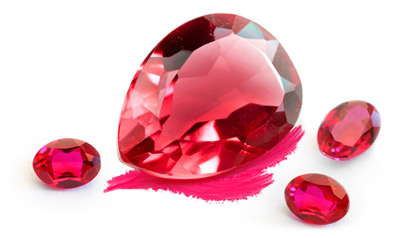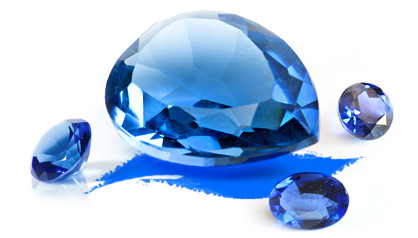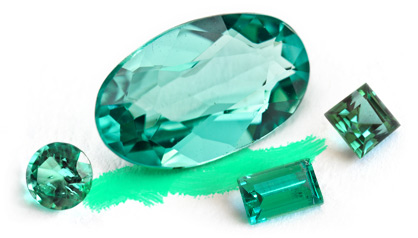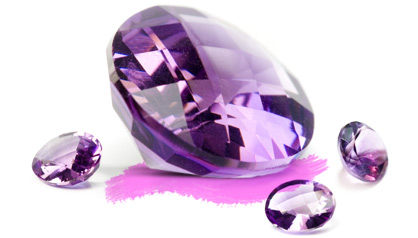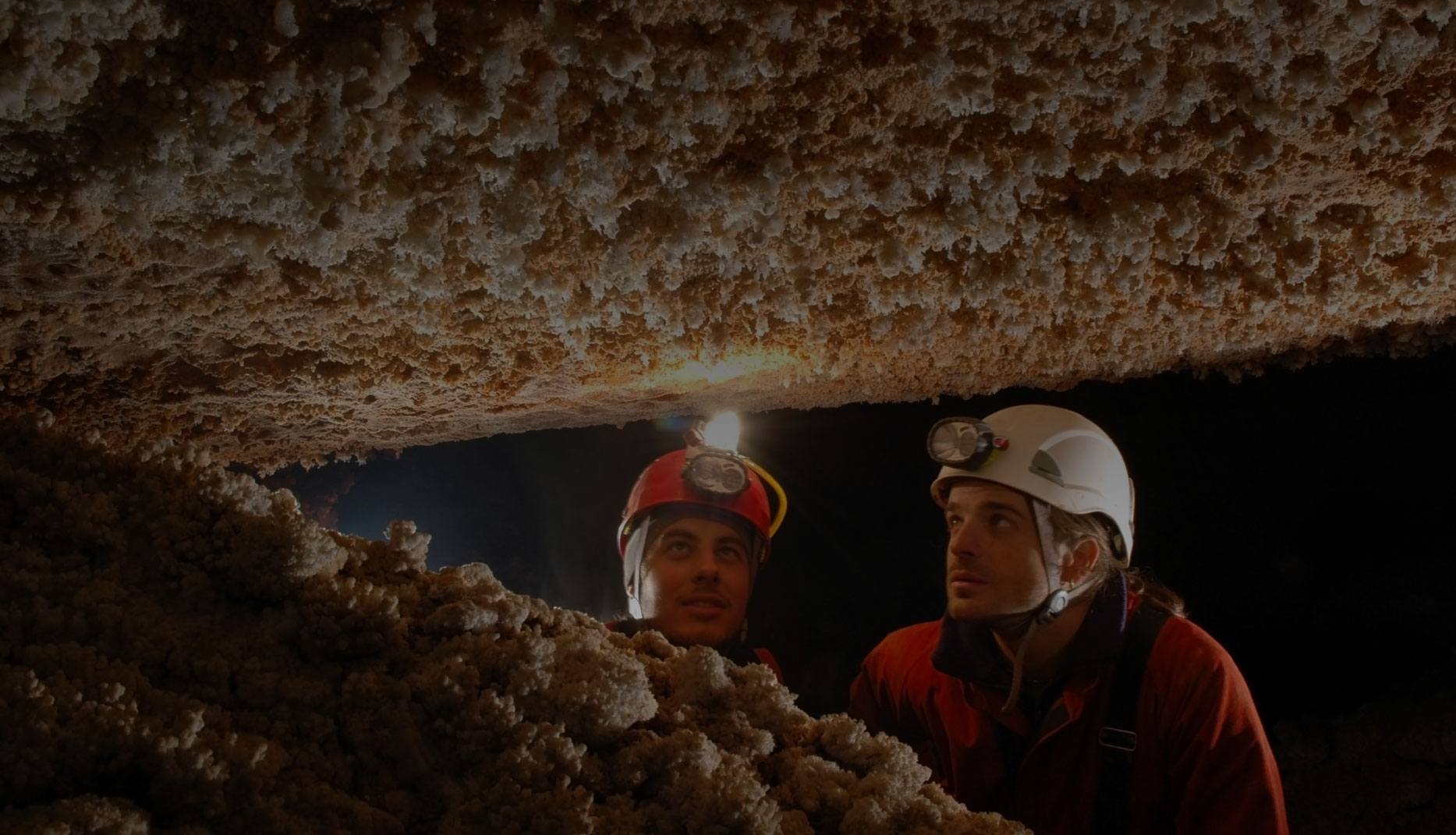The word tourmaline was derived from the Sinhalese word “turmali”, which means ‘many gems of mixed color’, a very appropriate name for the mineral group, as it does contains several species that each host their own suite of gemstone varieties. Possibly the most famously used species of tourmaline in the jewellery industry is elbaite, but very few call it by this name. Instead, dealers in the trade use the variety name of many tourmaline gems, such as rubelite (red), indicolite (blue / violetish blue), and verdelite (green). Some species, such as liddicoatite, named after the famous GIA gemologist Richard T. Liddicoat, can even display more than three or four colors in the same crystal.

Tourmaline as a Timeless Gemstone
If there is one gemstone group with an almost infinite amount of color variations, it would most likely be tourmaline. This unique and beautiful gem boasts crimson reds, electric blues and verdant greens, sometimes all in the same piece of crystal. The beauty with tourmaline is that it’s got visual diversity, as well as a global status. Many world-renown museums host gigantic in-matrix specimens of tourmaline’s many species. One relatively recent addition to the gem’s portfolio of unique varieties is the copper-based ‘Paraiba’ tourmaline, which has the trade much in demand for its neon to electric blue shades. All the same, its other famous varieties such as watermelon and bi-color tourmaline, have become popular choices for many modern jewelry designers and artisan brands.
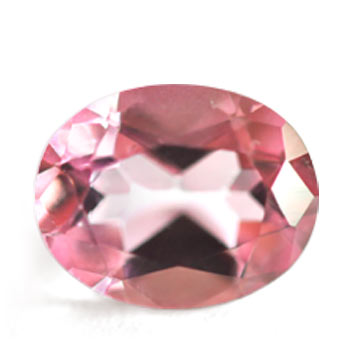
An Imperial Favorite
China’s Empress Dowager Cixi desired tourmaline so greatly, that her quest for the stones reached across the pacific to US mines in California.

A Diverse Spectrum
The tourmaline group can have varieties in multiple colors, so the level of saturation is what collectors often adapt as a grading criteria.
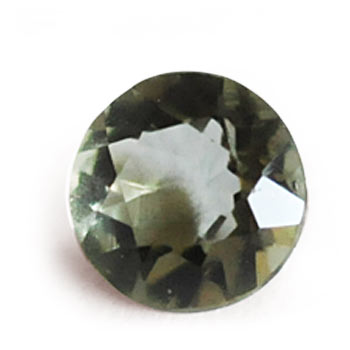
The Family of Minerals
Gemologists and mineralogists recognize more than a dozen different minerals species that belong to the diverse tourmaline group.
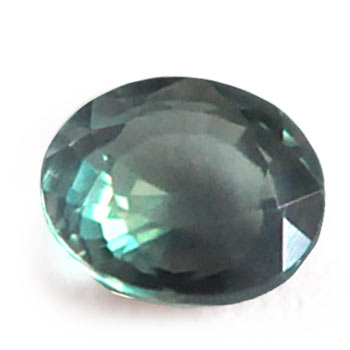
Gemstones for October
Tourmaline and opal are both famously considered as birthstones for those born in the month of October.
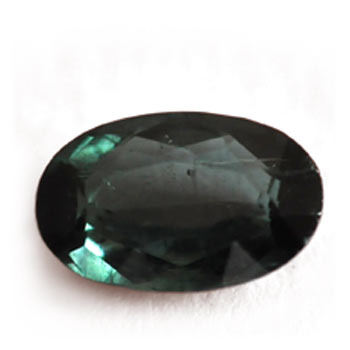
Elongated Crystals
Many stones are oriented as mixed cut gems, but tourmaline is often fashioned into a long emerald-cut or drop-shape due to its crystal formation habits.

An Island in Italy
Currently the most popular jewelry-used tourmaline species; Elbaite, was named after the isle of Elba in Italy.
"Many tourmaline varieties that we see on the market originate in certain types of mineral-rich geological environments. Some species require rare elements to complete their composition, and these elements must be present in the crystallization process in order for tourmaline to grow with its unique visual characteristics. Such a concentration of elements can sometimes be found in geological formations called ‘pegmatites’. These natural environments can be host to a wide array of tourmaline-related elements like lithium, sodium and many others. Crystals of tourmaline can have a variety of elements in their composition, due to the group’s wide roster of member species. Each type of tourmaline can also display vibrant colors that are uniquely drawn from their chemical make-up."
One country that is very famous for producing almost every color of tourmaline is Brazil, especially within the exotic region of Minas Gerais, which also happens to produce other gemstones like aquamarine and quartz. Large amounts of gemstone production have been attributed to Brazil’s unique geological conditions, and the local governments have therefore capitalized on the precious ores found in the country’s territory. Many often believe that Minas Gerais is one of the gem-bearing capitals of the world, given its history and the diversity of gemstone species found there.
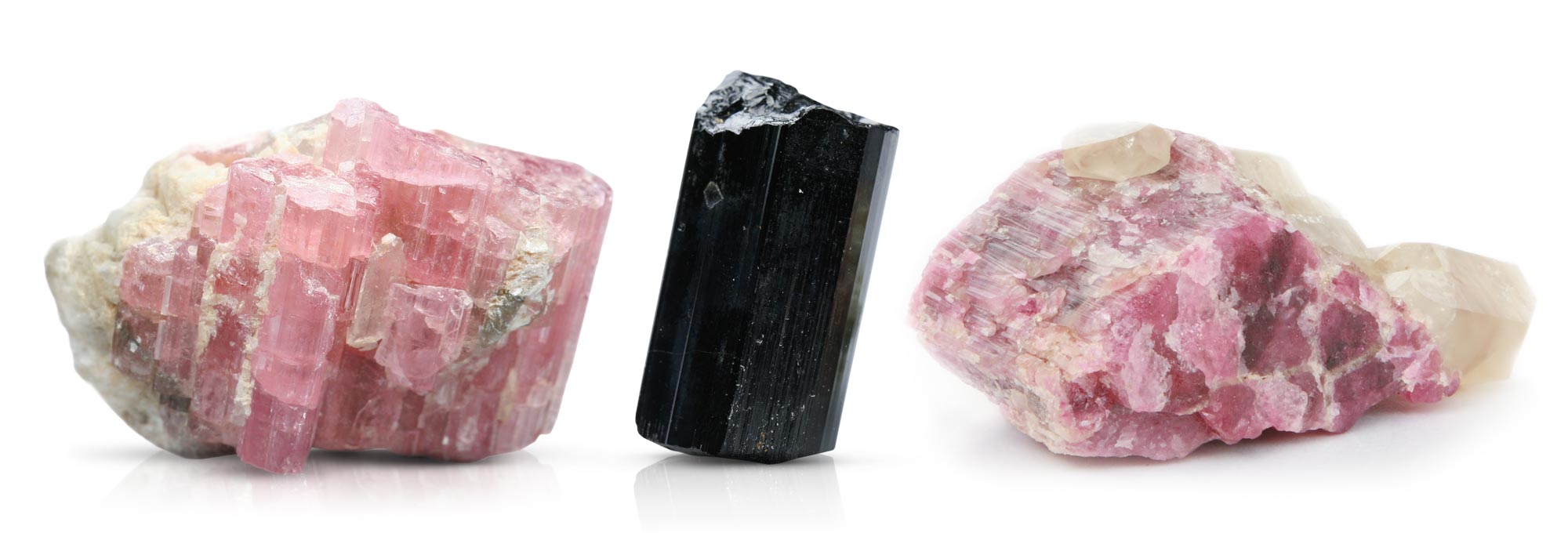
Above, we can see two rough crystal specimens of pink tourmaline surrounding a black prism of schorl tourmaline on both sides. People in many parts of Asia pefer the soft yet vivid colors of pink tourmaline, coveting both raw towering crystals and polished cabochons for their house collections and jewelry pieces.
Relatively recently, the brazilian northeast region of Paraiba has risen to enormous fame, due to the discovery of copper-bearing tourmaline deposits in 1989. These stones rapidly made their way up the demand ladder and soon became a staple for many mid-to-high end jewelry design firms. These modern gems can come in brilliant ‘light’ but vibrant bluish greens that many in the trade describe as ‘neon’. They sometimes also appear in a variety of ‘electric’ blues and violetish blues that possess a high degree of saturation. It’s quite common to see high-end specimens being displayed in individual showcases at the yearly trade fairs. Although ‘Paraiba’ has now become a term commonly used in the industry, the fact remains that copper-bearing tourmaline with these kinds of colors can still be found in other parts of the world. Some have claimed that Mozambique possess a couple of tourmaline mines that can produce similar output, although many of the exported goods are still sold as ‘Paraiba’ tourmaline due to the trade term’s popularity. Still, the neon or electric colors aren’t the only varieties of tourmaline that are currently being talked about in the industry. A widespread appreciation for rubellite tourmaline has been recognized for the past several decades, and still continues to this day. Such long-term admiration might be attributed to the famous stories of many gem connoisseurs. China’s empress dowager Cixi has been noted to be one of history’s most passionate collectors of rubellite tourmaline, mainly due to her many commissioned ventures reaching as far away as California in the United States of America. The trade’s more modern demand for this variety of tourmaline has also caused the discovery of some irradiation treatments that can induce or improve the pinkish color of certain crystal specimens.
Other well-known varieties of tourmaline include indicolite and verdelite, referring to the darkish blue and green varieties of the gemstone respectively. These kinds of tourmaline are frequently seen in trade shows, but often command lesser price points compared to both rubellite and ‘paraiba’ tourmaline. The reason for this may be that supply is more available for these colors of the gem, however there does exist a more vibrant green variety called ‘chrome tourmaline’ that is said to showcase a high level of saturation in much smaller millimeter sizes.
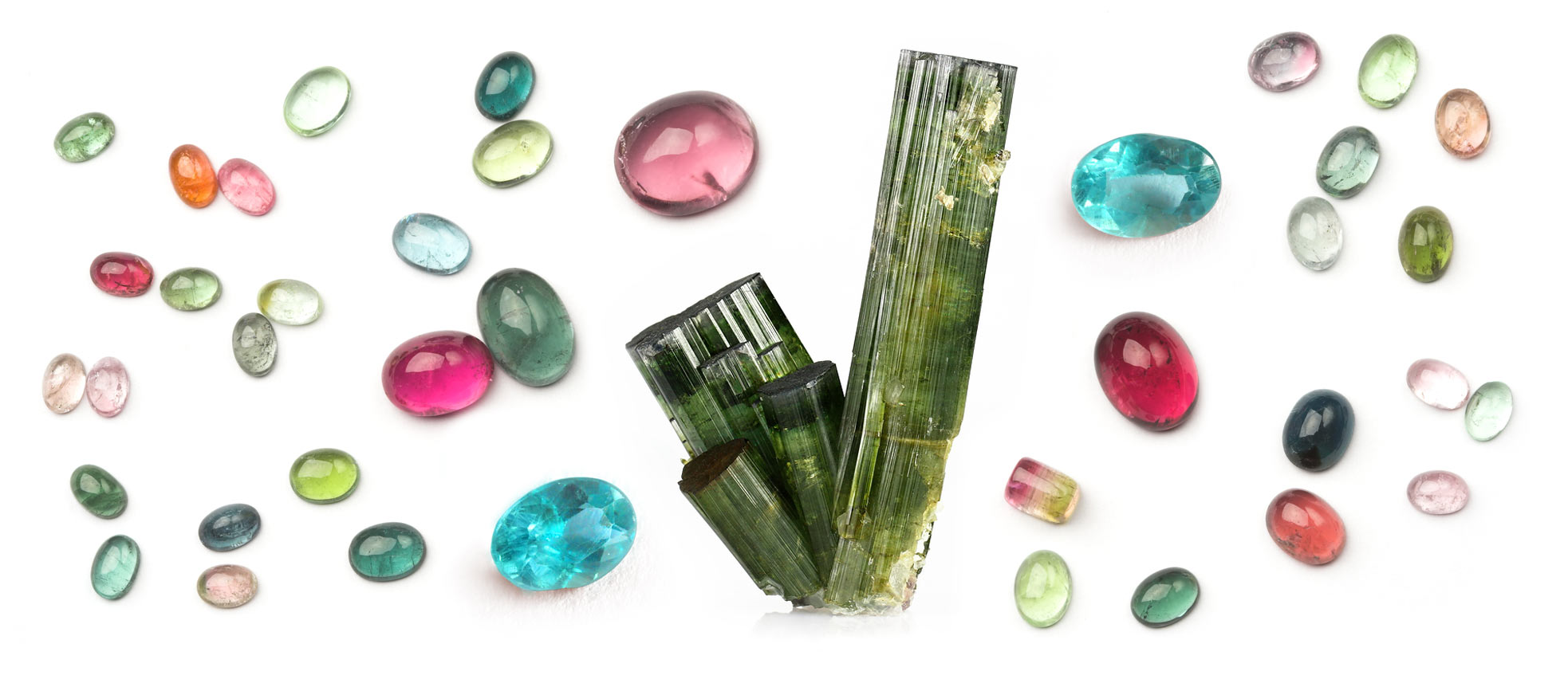
A premium also exists for rare varieties of tourmaline such as the ‘rainbow’ or parti-colored varieties of a species called liddicoatite. These specimen examples don’t always need to be faceted for them to attain high value prices. The mineral crystals of liddicoatite can sometimes grow into large columnar structures, while displaying multiple hues of color, such as green, blue, red and yellow. Furthermore, many bi-color examples of tourmaline can also achieve notably high prices due to their popularity with fashion trends and seasonal collections. Many jewelers only work with two types of bicolor gems, namely ametrine (a variety of quartz) and bi-color tourmaline, of which the latter is usually more expensive. Collectors seek out such exceptional pieces and include them in personal collections or shop exhibitions. Tourmaline remains to be one of the most highly sought-after colored stones in the jewelry market today, garnering the collective attention of world-renown jewelry artists and international design houses alike.
Caring for Jewelry Items and Evaluation of Gemstones
Tourmaline constitutes a pretty durable gemstone group. Most generally range in between 7.0 to 7.5 on the Mohs hardness scale, but each stone should still be kept away from contact with another stone (especially harder gems like diamond). Any tourmaline that has been treated may require special care. Some reddish tourmaline could have undergone mild irradiation treatment, which means that there is some possibility of color-fade upon over exposure to sunlight. These stones are best kept in jewelry boxes when not in use. Likewise there should always be special consideration for other examples that possess durability-causing inclusions like large fractures.
Jewelry Repair
Some chemical-based cleaning agents may be harmful to certain stones, especially those that have undergone treatment processes. Torch heat can also affect some large enough liquid inclusions, which are very common in many tourmaline stones. Irradiated examples may also be altered by high temperatures as well.
Frequently Asked Questions

Is rubellite similar in value to ruby?
Rubellite tourmaline is a precious gemstone in its own right, and is not related to the ruby variety of corundum in any way. That being said, there is a distinct difference in value between fine color ruby and fine color rubellite. The latter, while still considerably expensive, would fetch for much less than its ruby counterpart. The reason for this is a combination of historical heritage, rarity and current market popularity. Comparing these three aspects for ruby versus the same for tourmaline would give strong basis for the price difference.
How blue or green does tourmaline have to be in order to be labeled ‘paraiba’?
This topic is one that many in the industry frequently debate over. Generally though, what allows a gem to be called ‘paraiba’ is rooted in two distinct facts according to most traders. The first is that the tourmaline must be primarily colored by the element copper and the second is that the gemstone must possess a considerably high saturation with a tone that is not too dark or medium dark. We must always understand though that there are no ‘governing’ rules to enforce these conditions in many national courts. Always be careful when buying any kind of gemstone, have a professional gemologist look over its details as well.
What if a Paraiba tourmaline is found to originate from another locality?
The trade term ‘paraiba’ although named after that locality in Brazil where the stones were first popularized, usually refers more to a standard of color and saturation. The fact that copper is the cause of its color is also greatly recognized by both sellers and buyers alike. Many traders sell tourmaline from Mozambique as ‘paraiba’ if the color and composition of the stones are exact enough. This doesn’t mean though that no one pays a premium for tourmaline stones with sourcing papers from the Paraiba province.
How can you tell if red or pink tourmaline has been irradiated?
Most modern day irradiation techniques used to enhance reddish or pinkish colored tourmaline cannot be detected. The natural counterpart can acquire its color from a few different sources, one of which is a natural exposure to radiation from the earth. This is why there is considerable difficulty in separating the treated ones from the naturally irradiated gemstones. Both are actually vulnerable to color-fading under strong exposure to light, though the degree of fading can vary greatly from stone to stone.
What is Schorl Tourmaline?
There are many species and varieties that belong to the tourmaline group. Schorl is a fairly frequent species that is relatively inexpensive when compared with other varieties like rubellite. This species is also known as black tourmaline, even if some of the other species can also crystallize with black colors. Schorl is probably the most common tourmaline mineral that can be found nature, making up over 90% of all tourmaline according to many mineralogists. It is sometimes used in jewelry, when designers desire an opaque, jet black but reflective gem material.
How come some tourmaline gems are very dark?
When tourmaline crystals grow, they do so as columns. If you look down through the column from top view, the color of the gem is much stronger. This can be good at times, but it can also appear too dark in other situations. Depending on the skill, opinion and purpose of the gem cutter, the raw crystal can be cut up and oriented in different ways to promote or hide the direction with the stronger color.
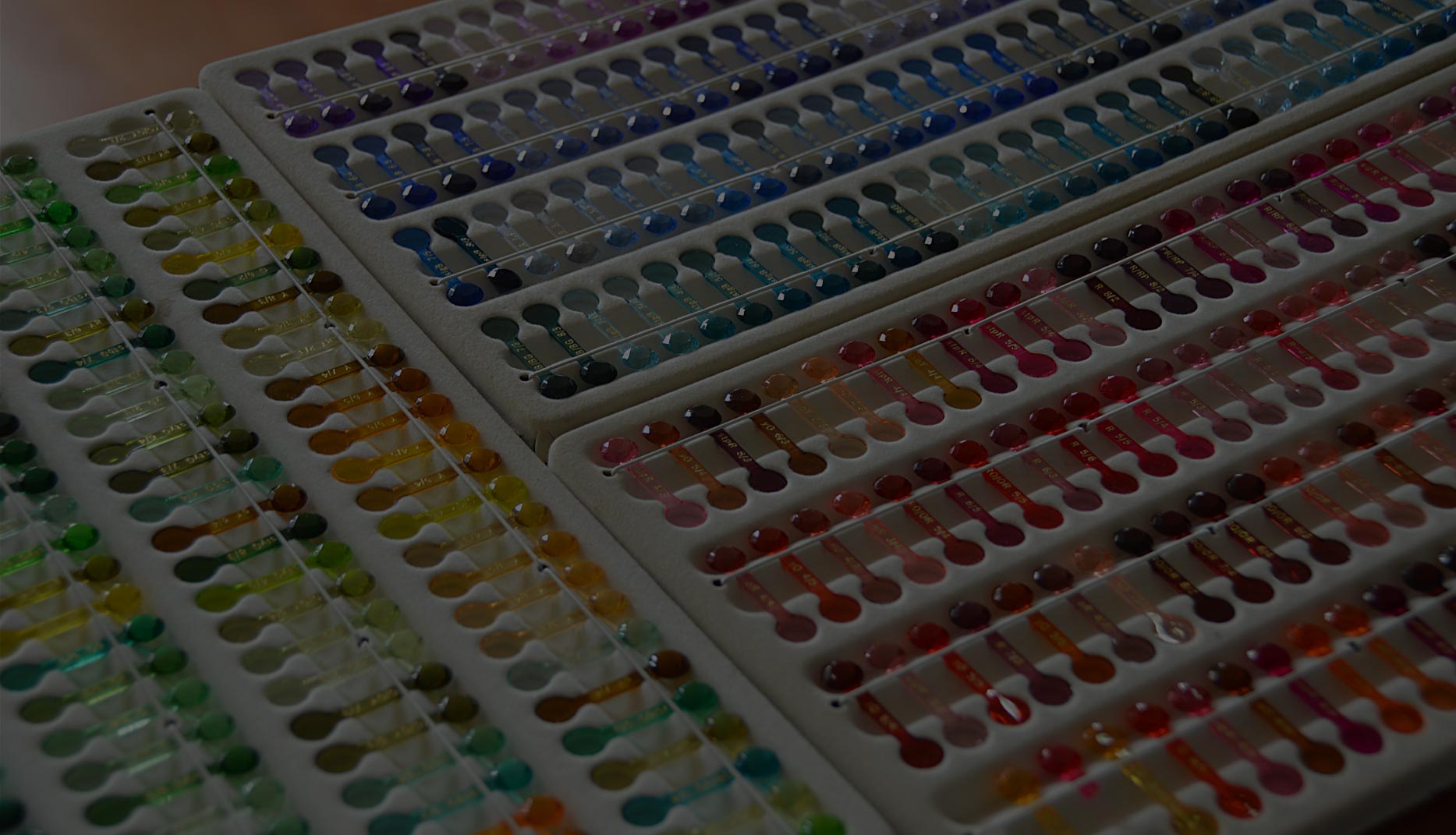
Tourmaline Gemological Information
Gem Group:
Tourmaline
Composition:
Varies
Multiple
Hues and Tones
Refractive Index:
1.624 to 1.644
Specific Gravity:
3.06 (+0.20, -0.06)
Hardness:
7 to 7.5 (Mohs)
Gemologist's Lab Notes
The Scientific Identification of Tourmaline
The different species that belong to the tourmaline group are essentially boron silicate minerals that also possess different amounts of some other elements, such as iron, sodium, magnesium, lithium, potassium or aluminum. Depending on the specific composition, gemologists can determine the species of tourmaline a certain crystal in the group belongs to. Not every species is commonly used in the jewelry trade, only about a handful of them have the color, durability and properties required by most designers today.
Tourmaline gems are often easy to distinguish from other stones due to their unique set of observable traits. The first would be a very consistent degree of birefringence, which can be seen with the refractometer and a simple polarizing filter. Tourmaline’s RI value is a range that can vary a little depending on the species. Generally, it can start from somewhere around 1.61 or on the opposite extreme, end at around 1.698 at maximum, but it usually holds at around 1.62 to 1.64 for most species (noting the 0.20 birefringence). Turning the polarizing filter 90 degrees will shift the value from 1.62 to 1.64 in this case, thus allowing us to observe tourmaline’s characteristic birefringence. This strongly doubly refractive gem is also famous for showcasing a distinct pleochroic observance. The dichroscope view will normally show you two colors of generally similar hue, but one will have considerably darker tone than the other. This characteristic is seen quite often in tourmaline stones, and can help gemologists with their analysis of gem identity. Some bicolor or parti-color tourmaline gems can make viewing pleochroism a bit confusing if the stone is fashioned in certain ways. Take your time in finding the correct angle of viewing, and make sure that what you’re seeing is pleochroism, and not color zones.
Is there any manufacturer of Synthetic Tourmaline?
So far, we have not yet observed any viable or ongoing existence of a commercial-scale synthetic tourmaline manufacturing process. It is entirely possible that man-made tourmaline is present somewhere in the world, but the general consensus of most dealers is that no method for creating tourmaline has really been used commercially or to the extent that would create any serious problems in the market. Despite this news, there are many unethical vendors who sell gemstone simulants (a.k.a. imitations) as synthetic tourmaline. Some of these simulants include green glass, spinel triplets and cubic zirconia. It is quite easy however, for most gemologists to separate these types of gems from tourmaline due to differing gemological properties.
The Pyroelectric Gem
Pyroelectricity is a property that allows some materials to generate electric energy for a temporary period of time, upon exposure to certain temperatures. The effect was first noted by a philosopher and scientist named Theophrastus, who observed that crystals of tourmaline created an electric-based attraction when exposed to a flame. Though despite this interesting fact, tourmaline is a completely safe gem (to those of you who are curiously paranoid) for usage in jewelry. This information is more for trivia, explaining the unique characteristics of a gemstone that many consider to be one-of-a-kind in the world of mineralogy. Collectors often find this property to increase the novelty of their prized tourmaline gemstones.

Facet Junctions Doubling?
Because of tourmaline’s strong birefringence, if you look into the stone using a microscope (or sometimes with a loupe), you may notice that the back-facet junctions duplicate or “double” themselves a short distance away from their original positions.

A Suite of Liquid Inclusions
Tourmaline is one of those gemstones with a tendency to possess liquid inclusions. These can be described as two-phase inclusions (liquid and gas), or sometimes three-phase inclusions (if by chance there is a solid piece of matter inside the matrix).

Pleochroism & Tone
You can use pleochroism to support your gemological identification when dealing with tourmaline gemstones. Most of them display one box color significantly darker in tone than the other, with hues being nearly similar (when viewing one area of color on the gem with the dichroscope).
Qualities, Value and Demand
Pricing Tourmaline can vary very greatly depending on variety. Here we have listed some common varieties and their quality levels, as well as our own price opinion on their market values. A good rule of thumb is to remember that higher saturation levels allow for higher values, but colors that become too dark can lower value significantly.

Despite trade debate about whether or not tourmaline should be introduced as a semi-precious stone, its value is comparatively high when seen against counterpart figures for quartz, peridot, topaz and some garnets. The range for tourmaline price has a very wide expanse, mainly due to the fact that some varieties like ‘Paraiba’ tourmaline have recently taken market demand to new heights. Though before anyone had ever heard of this neon colored rarity, the story of tourmaline’s rise to popularity was already one for the history books. Centuries ago, these little treasured gems from Sri Lanka’s native river gravels were noticed by the growing aristocratic population of western civilization. After some period of time, the Dutch East India Trading Company travelled to Ceylon (what people used to call Sri Lanka) in order to find and acquire these first batches of tourmaline for their rich European customers. It was a very common misconception back then to sell these stones as other gem species, such as zircons, although eventually these unique gemstones were brought to light as independent and unique varieties of their own. Many people soon became amazed at the fact that tourmaline could attract and repel hot ashes (due to pyroelectric property), and some even related this effect to ancient crystal curing beliefs and folklore.
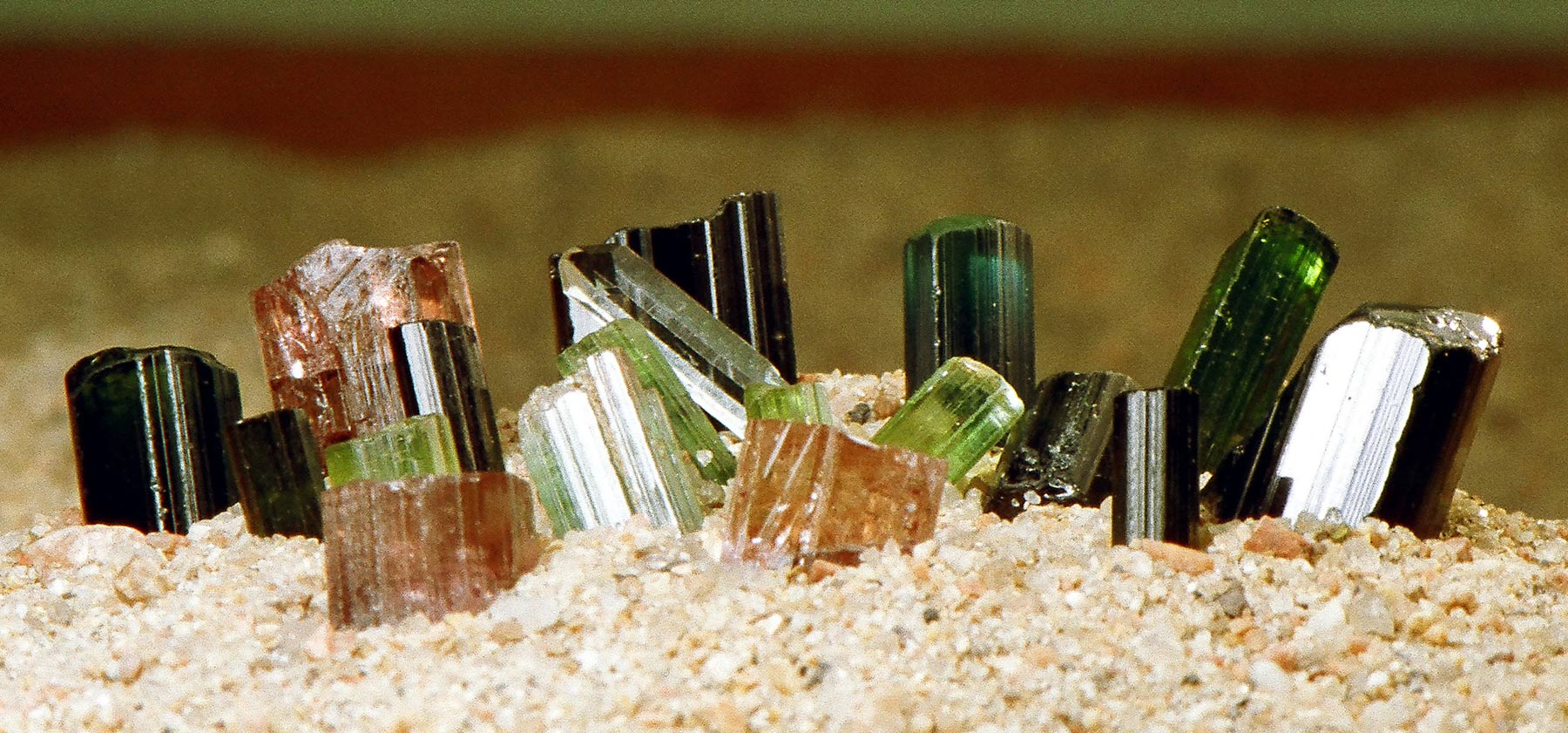
Tourmaline’s many colors became a curious asset to many in the olden days. Even jewelry designers back then became fascinated with the vast possibilities that could be done using this new diversity of hues. The trade quickly developed new names for a lot of vibrant tourmaline varieties that were imported from Ceylon, while others still referred to it as the ‘Ceylon magnet’ stone, due to the pyroelectric effect it was often known for. Much of the finer specimens that were imported probably belonged to the Elbaite or Liddicoatite species, both of which have already come very far in today’s worldwide gemstone marketplace. It’s possible to say that tourmaline’s amazing history brings to light a countless number of oceanic voyages, involving ill-tempered storms, exotic lands, and a gem-trade pipeline that has brought marvelous new possibilities to the world of jewelry.
Synthetics, Imitations and Treatments
As far as synthetics go, most believe that there still aren’t any commercially viable methods for man-made tourmaline production. On the other hand, there are several kinds of imitations already available on the market. These do not always target tourmaline directly, but sometimes target many gems with similar colors, such as ruby and rubellite or emerald and chrome tourmaline. Imitations (a.k.a. simulants) could be derived from manufactured products, synthetic versions of other gem species, or even natural versions of other gems. The possibilities are actually endless, and a lot of the more unethical traders can easily trick buyers who aren’t as familiar with tourmaline’s gemological traits.
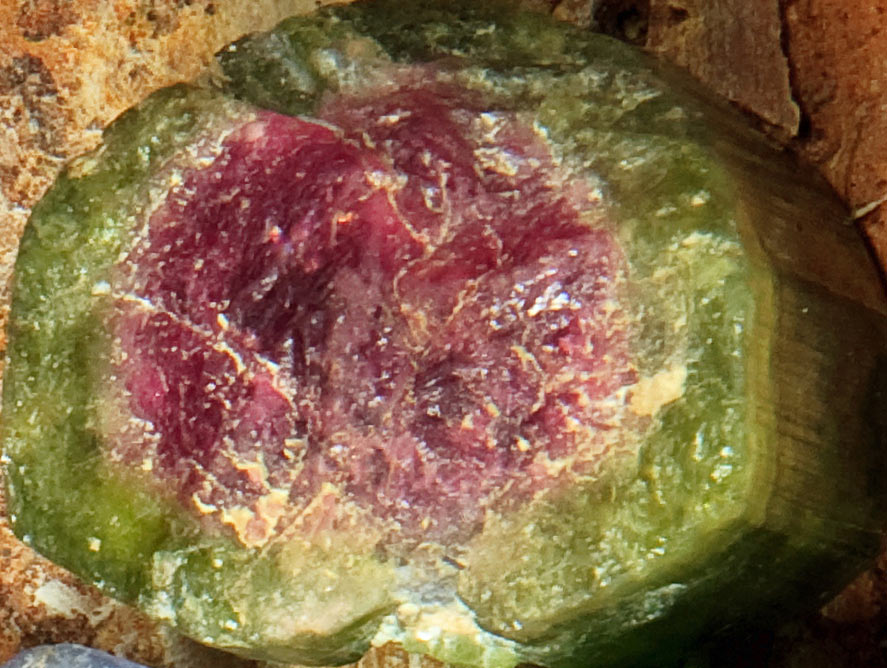
Natural | Watermelon Tourmaline
Reddish core and greenish exterior skin of watermelon tourmalineOne popular variety called watermelon tourmaline is often cut into bicolored faceted gems. It was named after its combination of red and green hues that resemble a watermelon's color pairing.
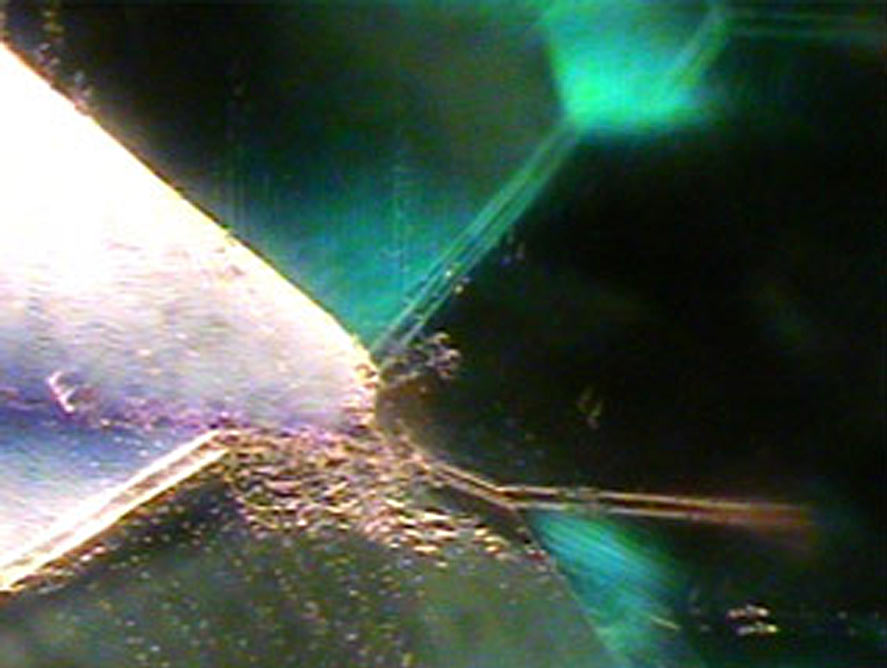
Trait | Back-Facet Doubling
Tourmaline's back-facet edges appear to double under microscopyTourmaline's high birefringence will cause you to see its back-facet edges double when viewed under high magnification or microscopy. This will not be visually observable when looking down an optic axis direction.
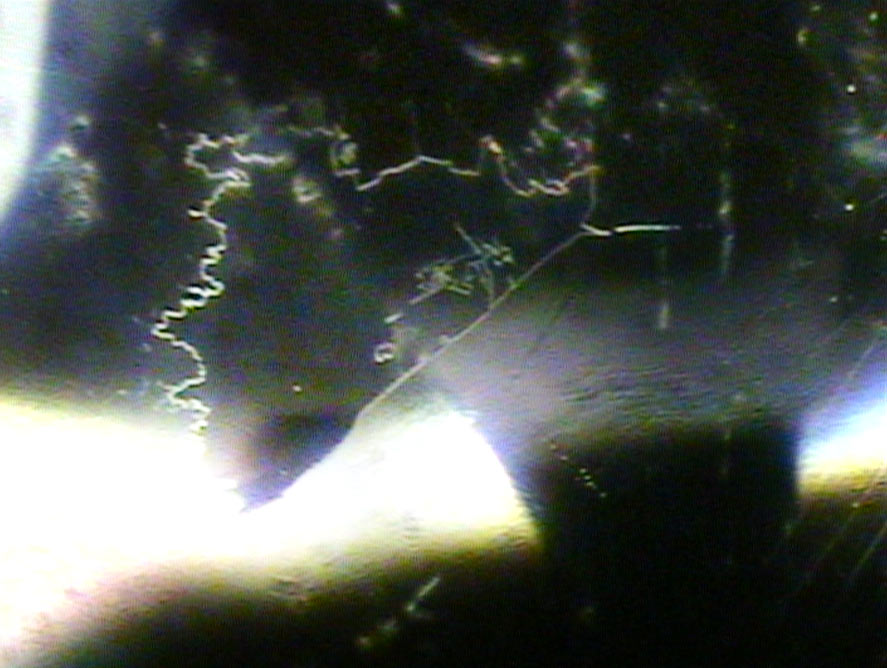
Natural | Liquid Inclusions
Mirror-like liquid inclusions commonly seen in tourmalineMany tourmaline specimens will show liquid inclusions. Some may appear mirror-like under microscopy, like this planar example.
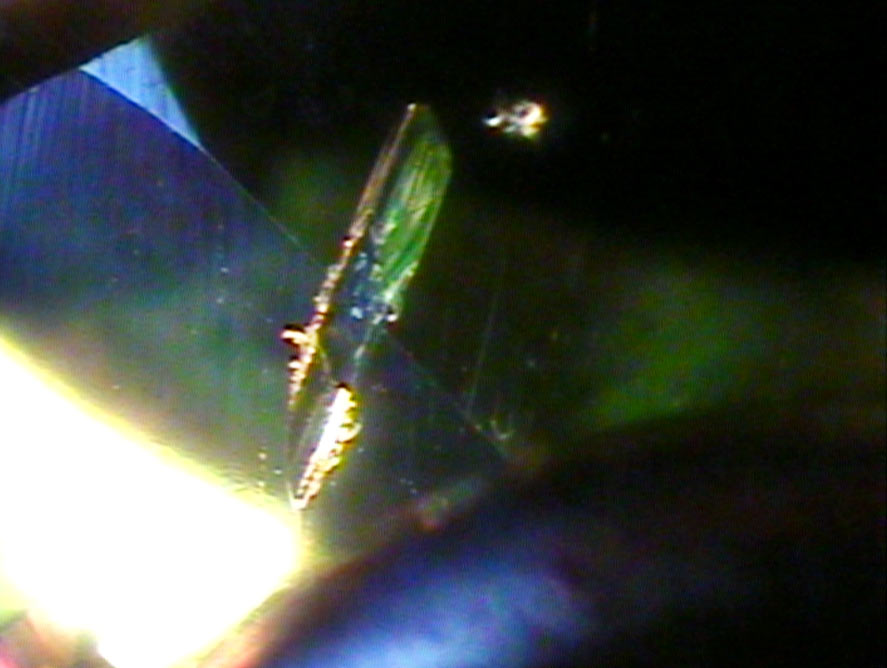
Natural | Crystal Inclusion
A mineral crystal inclusion inside a tourmaline gemstoneLike many natural gemstones, tourmaline may exhibit a variety of mineral crystal inclusions. These can help separate it from common man-made imitations like glass that may exhibit other microscopic characteristics.
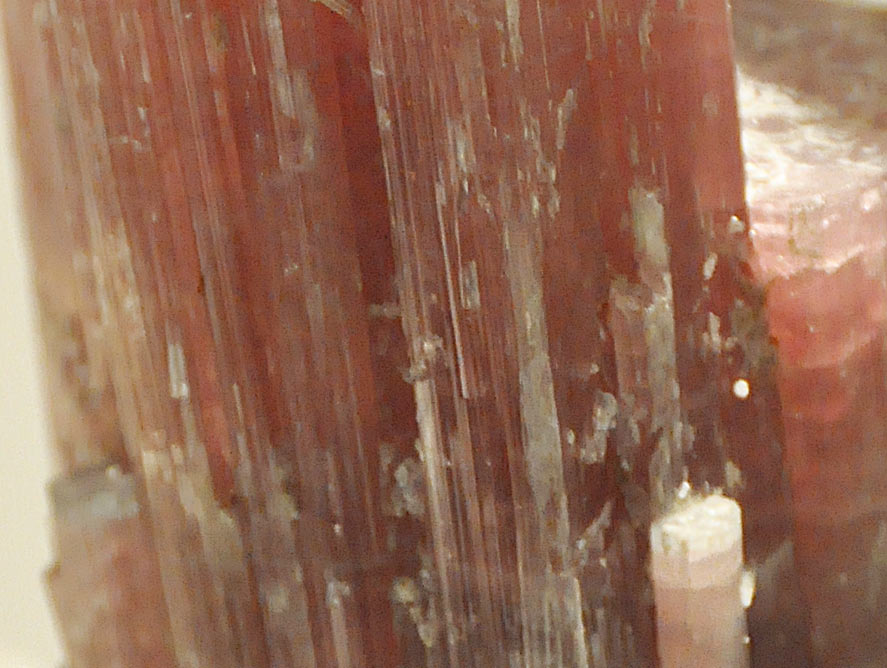
Natural | Vert. Striations
Raw tourmaline specimens will often show heavy vertical (parallel to long side) striationsRough tourmaline crystals tend to grow very characterisically. Most may be observed as elongated prisms with heavy striations running parallel to the crystal's longer direction.
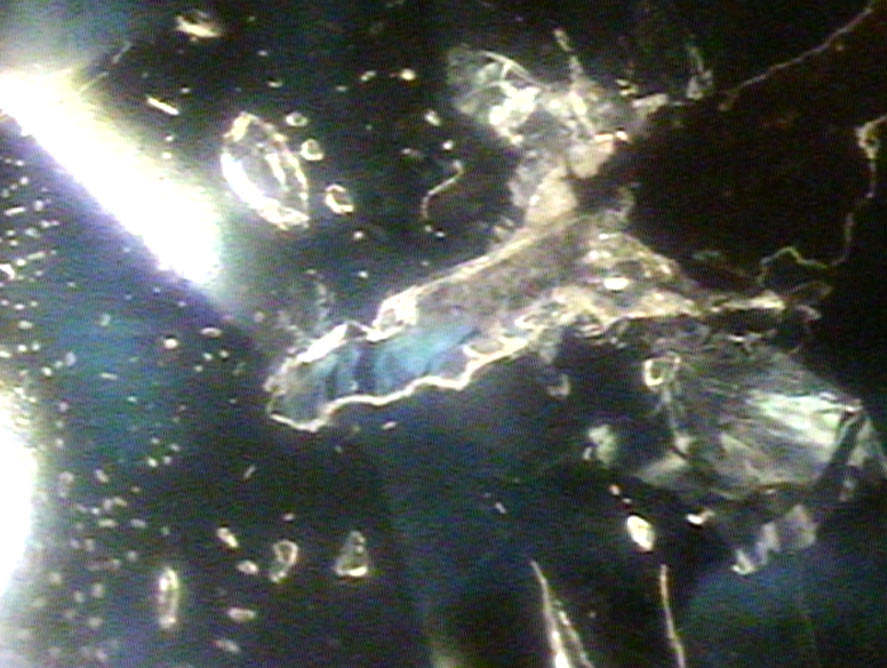
Natural | Inclusion Diversity
Both liquid and crystal inclusions within this tourmaline specimenIt is common for natural tourmaline to show a diversity of inclusion types. This sample shows both a mineral crystal and several liquid inclusions upon being viewed with magnification.
Contact Us
Get in touch with a Gemologist.
For gemological assessment requests, our laboratory evaluates gemstones as an impartial third-party assessor.



